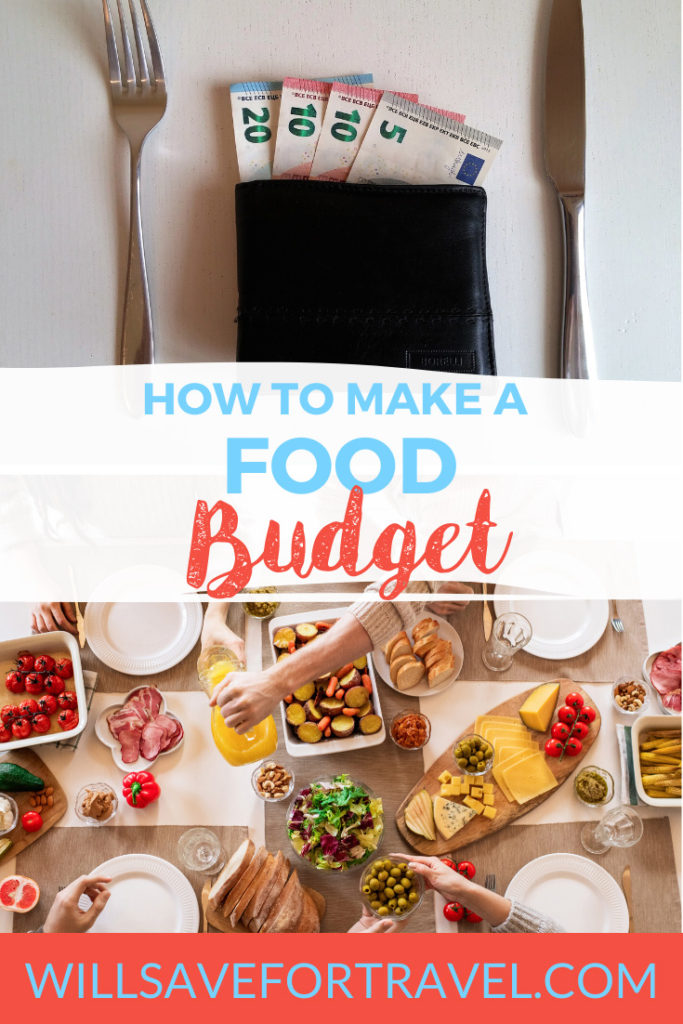How To Make A Food Budget
Budgeting Finance || Tags: budgeting, Food ||Inside: How to make a grocery budget; how to make a food budget you can stick to; how to spend less on groceries; saving money on food
Here’s the deal; everyone has to eat! When you’re making your monthly or biweekly budget you might be wondering how much you should budget for food or groceries. The actual number is individual, but here’s how to make a grocery budget, so that the rest of your money is free to buy other things (I’m looking at you, plane tickets!)


How Much Should We Spend On Food?
It depends… I know, not helpful! Obviously what we spend as a family of 2 adults will be different from you if you are single, or if you have children. It also depends heavily on where you live. Here in Canada, food tends to be a bit more expensive than the USA, and it is different all around the world.
In 2017 Statistics Canada released that the average Canadian household spends about $495 on groceries a month, and about $216 a month on restaurant food.
Most financial experts recommend spending about 10%-15% of your income on food for your family.
We personally average $168 every 2 weeks for groceries, and $38 every 2 weeks for eating out for 2 adults. This represents about 9% of our overall budget.
Some budget periods are higher and some are lower depending on the time of year and what we have planned!
How To Make A Food Budget
Step 1 – Determine Your Variable Expenses Budget
The first part of any budget is to add up your income and subtract fixed expenses like your mortgage or rent, insurance premiums and utilities. This will give you the amount you have to divide up between your variable expenses like groceries, eating out, clothing, gifts, and pets.
Read More: How To Make A Zero Based Budget
Step 2 – Review Old Purchases
Reviewing what you’ve been spending on food may be painful. Add up everything food related (groceries and takeout) that you’ve spent in the last few months to get a realistic picture. Decide if that amount is reasonable, or if you need to reduce the amount you are spending.
I recommend adjusting your budget slowly (unless you are spending more than you earn). If you try to go from spending $600 a month to $200 a month you likely won’t be successful and get discouraged. Try going from $600 to $500 and decreasing over time as you get better at budgeting and estimating costs.
Step 3 – Meal Plan
Meal planning will help you with your budget because it will help you make a list of what you need to buy! You can meal plan based on sales to save money on meat, etc. I have a master list of all our regular and fav meals, so that if I’m having trouble meal planning I can refer back to the list for some inspiration! You might want to plan meals that cost relatively little per person, in order to stay on budget!
Meal planning may include eating out – and that’s totally okay as long as it’s within your budget!
Step 4 – Estimate Costs Based On Facts
When making your budget, it’s not helpful to just write down a random number without looking at the facts. Estimate your budget based on your meal plan, and what you’ve spent in the past.
Don’t forget to look at your calendar to see if you have any plans like dinner out, or hosting a family dinner, this will impact your budget.
Step 5 – Test And Adjust
A budget is a fluid thing, changing based on what is going on in your life. Test your budget for a few weeks or months and see if it is working. If you are always going over budget, try to see where and why, then adjust your budget (or your behavior) accordingly.
We personally follow a value-based spending philosophy, so we sometimes spend more on something like local meat, which isn’t the most cost effective, but it is based on our values. It’s okay not to buy the cheapest item available!
Read More: How To Save Money On Groceries Without Coupons
How To Stick To Your Grocery Budget
Use Cash For A While
We used to take cash out of the bank every month when we first started budgeting. Psychologically it is harder for most people to spend cash vs swiping your debit card. It’s also easier to see how much you have remaining in your budget when you look at the cash in your envelope.
You may want to try using cash if you are consistently going over budget.
Track Your Spending Weekly
Your budget might not be the same every month or week and that’s okay! Budgets aren’t meant to be the same every month! Tracking your spending at the end of every week will help you see how much you’ve spent and how much you have left to spend for the remaining period (month or biweekly).
Remember Why You Are Doing It
With any budget, it’s important to remember why you are doing this in the first place. Staying within your grocery budget means that the rest of your money can be used somewhere else: to become debt free, to pay for that vacation you’ve always wanted to take, or to retire early to spend more time with your family.
Read More: My Why – A Personal Post
Final Thoughts
I know it can be a frustrating experience to budget, especially if you go over budget, but it’s worth it! Do you have any tips for creating a grocery or food budget?




Leave a Reply
You must be logged in to post a comment.